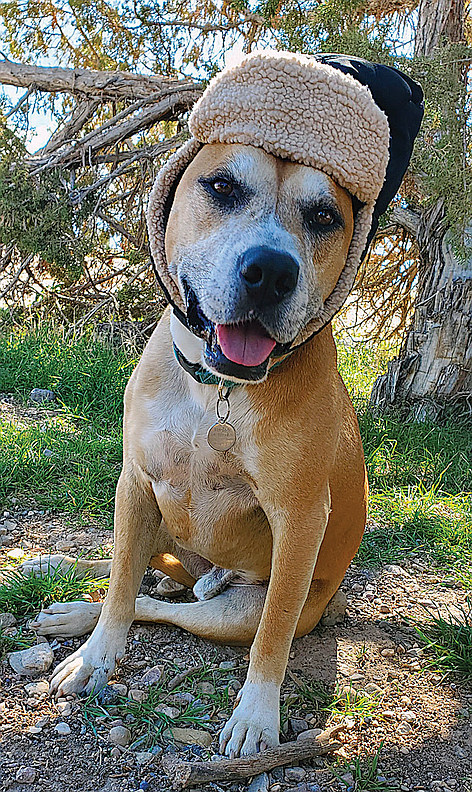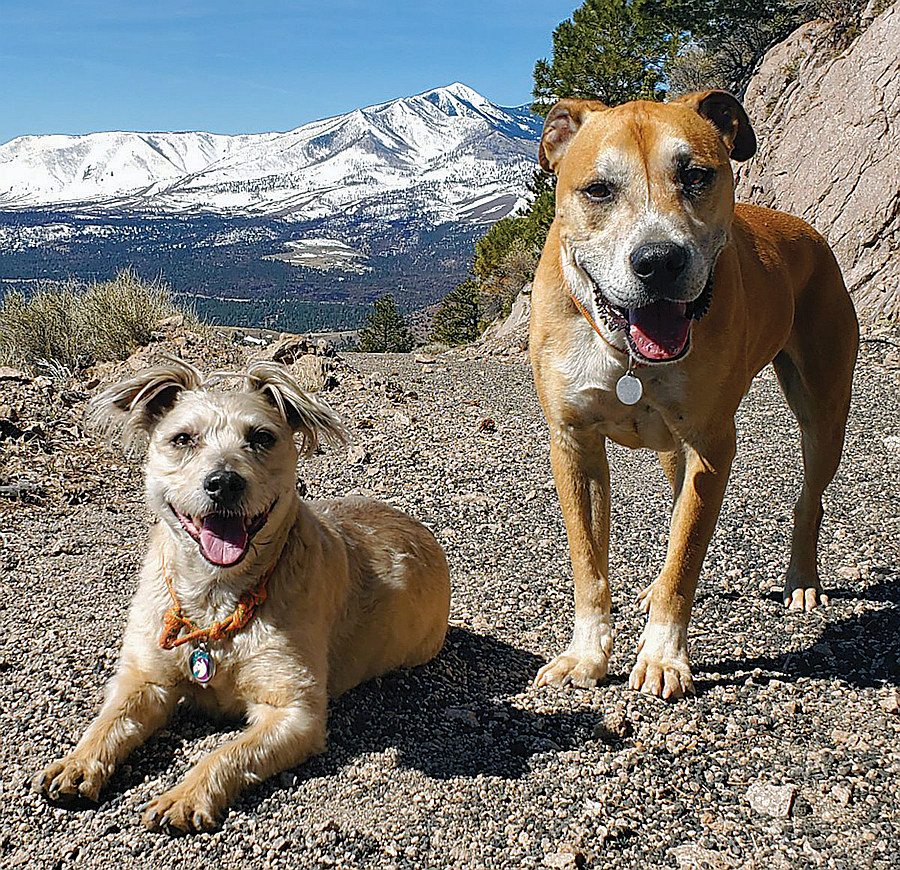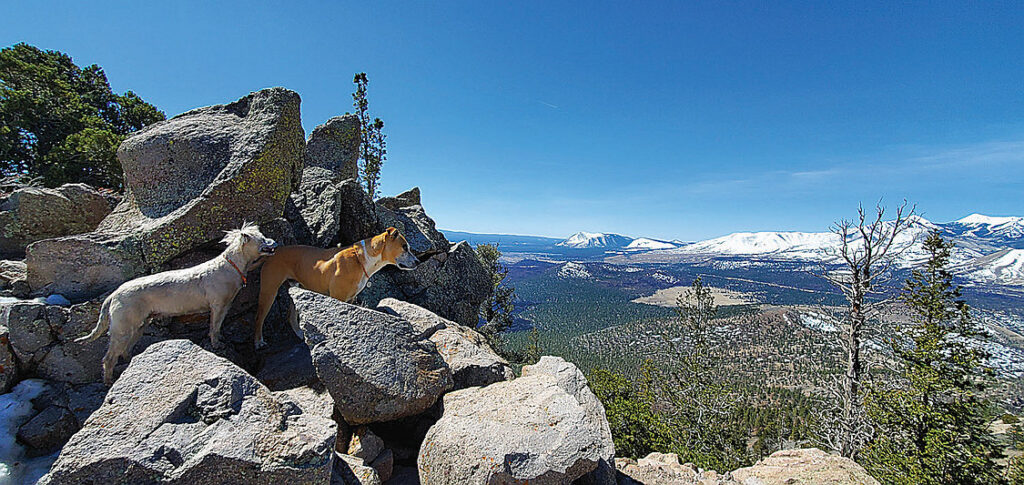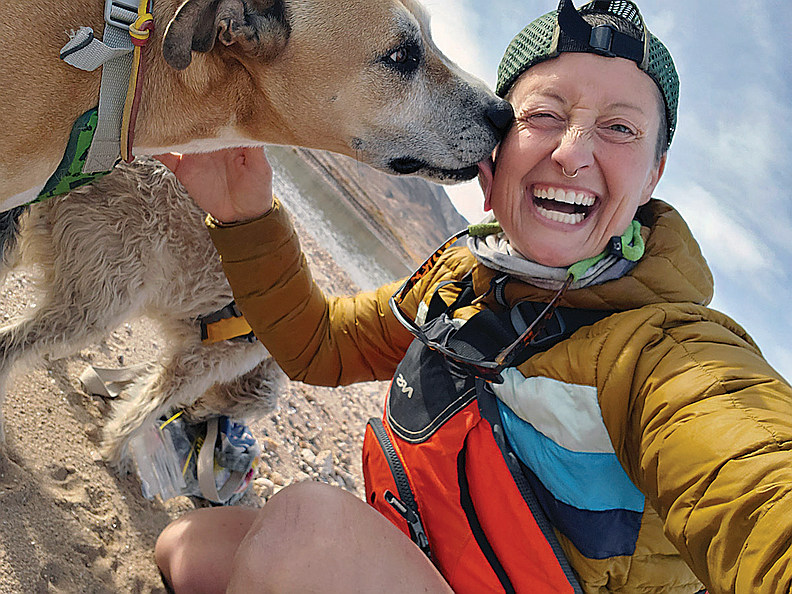[Grounded Pack Leadership Instead of Aggressive Dictatorships]
By Solana Kline

My two pups just had a relationship testing moment. Driving to town in the Tacoma, and these two dorks sit on an exquisitely padded platform where the backseats used to be so that they can see out the windows and catch all the best sniffers whilst we roam on the road.
Betty, aka Silver Back Sausage (the 30-lb. ex-street dog terrier) has wedged herself in as close as she can get to my mouth, a mouth which is currently eating a magnificent breakfast burrito, and if she can’t have any of the cheesy eggie morsels in her gob, she certainly feels that whiffs of it are a close second.
In doing so, she sardines Mickeyaka, aka Senor Lioness (the 65-lb. ex-fighting Pibble/Boxer), against the rear window. He finally tires of being squished and tries to stand up and turn around. But with the sandbagger Betty cemented to her prime breakie sniffing location, he only makes it halfway, consequently sitting on Betty’s head. They linger in this hilarious and heartwarming position for a minute or so, neither bothered or impositioned by the hilarity of their posturing. I snag a picture, and am filled to the brim with pride over these two being so relaxed around one another.
My pups are both adopted: Betty from Oregon Friends of Shelter Animals (ofosa.org), and Mickey from the Nevada Humane Society in Reno (nevadahumanesociety.org). They each had their fair share of unwarranted abuse from humans and dogs which shaped their social behaviors, just like we as humans learn our social behaviors from the people and events around us. This left both pups very scared and aggressive. And when we first added Mickey to the pack, they fought unpredictable bloody battles to the point that I thought I might have to bring Micks back to the humane society (something I thought I would NEVER do!).

My relationship with Mr. Mickey has completely changed how I live with and train my pups. Mickey had been at the Nevada Humane society for almost two years because he was so shy he couldn’t be in the viewing area, and he was also very dog aggressive. Mickey had learned that interacting with humans and dogs meant danger, violence, aggression, starvation, thirst, freezing cold, blazing heat, and overall, a life of suffering. He was lacking love, companionship, trust, and bonding—true elements of pack behavior!
Mickey is an amazing example of how an extremely dog-aggressive dog can heal from his traumatic past and learn to trust in the safety of play and comradery—to enjoy his life! This is a big deal because dogs who are aggressive most often get euthanized, especially pit bulls.
According to the ASPCA (tinyurl.com/bddntvw4), every year 390,000 dogs are euthanized in the US. This is so many of our potential pack pals sent up to doggie heaven without getting to experience the joy of a warm loving pack and home. So, if Mickey can do it, so can other learned-aggressive pups!

I think what many of us humans don’t realize is that true leadership comes from being calm and grounded in our position as pack leader. True leadership does not come from frenetic aggression enacted to assert our dominance, or from anxious fear. A calm, confident, and grounded pack leader sets the tone for the entire pack: our pups learn what to trust and how to build confidence and relationships from our actions and interactions.
One of the toughest things I see out on the trail is a human screaming frantically that their dog is aggressive. They yank back their dog and very clearly set tone for their pup that the situation is very dangerous! So, of course the dog will respond as such. I am no expert, but in my experience training several extremely aggressive dogs, all it takes is the most minor shift in my thoughts and pheromones for my dog to sense my fear or apprehension, leading them to shift into protective and aggressive behaviors. Our dogs are pack animals!
It is our responsibility as calm confident pack leaders to be aware of where and how our doggies are feeling each day, to be aware of how WE are feeling when we are out with our pups (the second I feel nervous or anxious, my dogs are more aggressive), to look ahead at potential triggers or situations that might set our pups up for failure, and to be in the present moment connecting with our pups when we are helping them learn how and who to be in the world!
Mickey went from literally Jaws attacking dogs from the bushes to being soooo happy and proud of himself every time he is brave and calm enough to waggle his tail and sniff new butts! As we have gone through the years together, we all have learned so much about trust, bonding, play, and safety.
I have learned how ruling a pack through terror akin to that of a South American dictator is the least effective way to lead and train. It’s ruling through fear, not trust; no one trusts a violent dictator! Instead, it’s been important to provide Mickey with a lot of exercise (essential for all dogs if you want them to behave and bond!), so much love AND space when he needs it (letting him choose his own comfort boundaries with space), and very positive experiences socializing and building his confidence with other dogs.
Micks had zero clue that play was not violence. He didn’t understand socializing because he was isolated and starved until he had to fight, which means his initial interactions with humans or dogs were extremely violent. Over a few years, Betty kept building up little play exercises with Mickey, and we both gave him space and love—space to mess up and try it out. We practiced safe and calm interactions meeting new friends.
I sat with him calmly as doggies walked by and radiated positivity for him to feel that we were safe, and the situation was safe. He eventually stopped being so violent, he safely plays rough with Betty (her favorite!). He just started rolling onto his back for tummy pets (amazing!), and he makes friends everywhere we go!
We can’t be certain of other dog or human behaviors in our encounters, but we can best set ourselves and our pups up for success in these situations. We can understand that, just like ourselves and our human experience, our pups have gone through trauma that they don’t understand and didn’t deserve. They have acquired triggers that need healing, trust, and positive experience.
With Mickey, I was just working with him intuitively, listening to what he needed. This wasn’t the most efficient method sometimes, but there are really neat resources now that can help us train our aggressive friends. Maybe it would even work on the disgruntled humans in our lives!

Training with positive reinforcement is the key here. The benefits of this strategy are immense: Building trust and bonds, reducing boredom, building your pups own confidence, and clear understanding of what their pack rules are to be a successful packmate! Check out the benefits of this approach here: tinyurl.com/wju3z5df.
Important here is for us humans to manage our own demeanor. Dogs can immediately sniff out the human who is pretending to be happy and positive to mask their fear or anxiety. Our pups need us to be grounded and calm in our positive training, and heck, it ain’t too bad for us to be this way either! So how do we do it?!
There is a neat approach that I came across recently that can help extreme dog aggression. It’s called the Bubble Theory. It is a training approach that slowly minimizes a dog’s individual trigger reactivity space bubble. Watch the video in the link here: tinyurl.com/yn4zjdbn.
In the end, it boils down to us paying better attention to our furry farty friends, seeing when they get nervous or anxious, observing when they are happy and relaxed. What and why did they feel anxious versus relaxed and happy? How can we be calm and confident pack leaders where our pups feel safe? Cesar Milan has done much work with this: tinyurl.com/bd7uc2pr.
Our energy becomes indicator to our dogs of how they should respond and interact in all contexts. So, for ourselves and for our four-leggers, lets remain calm! Let’s give them and us the peace we all deserve!
Until next time, happy tails and happy trails!


